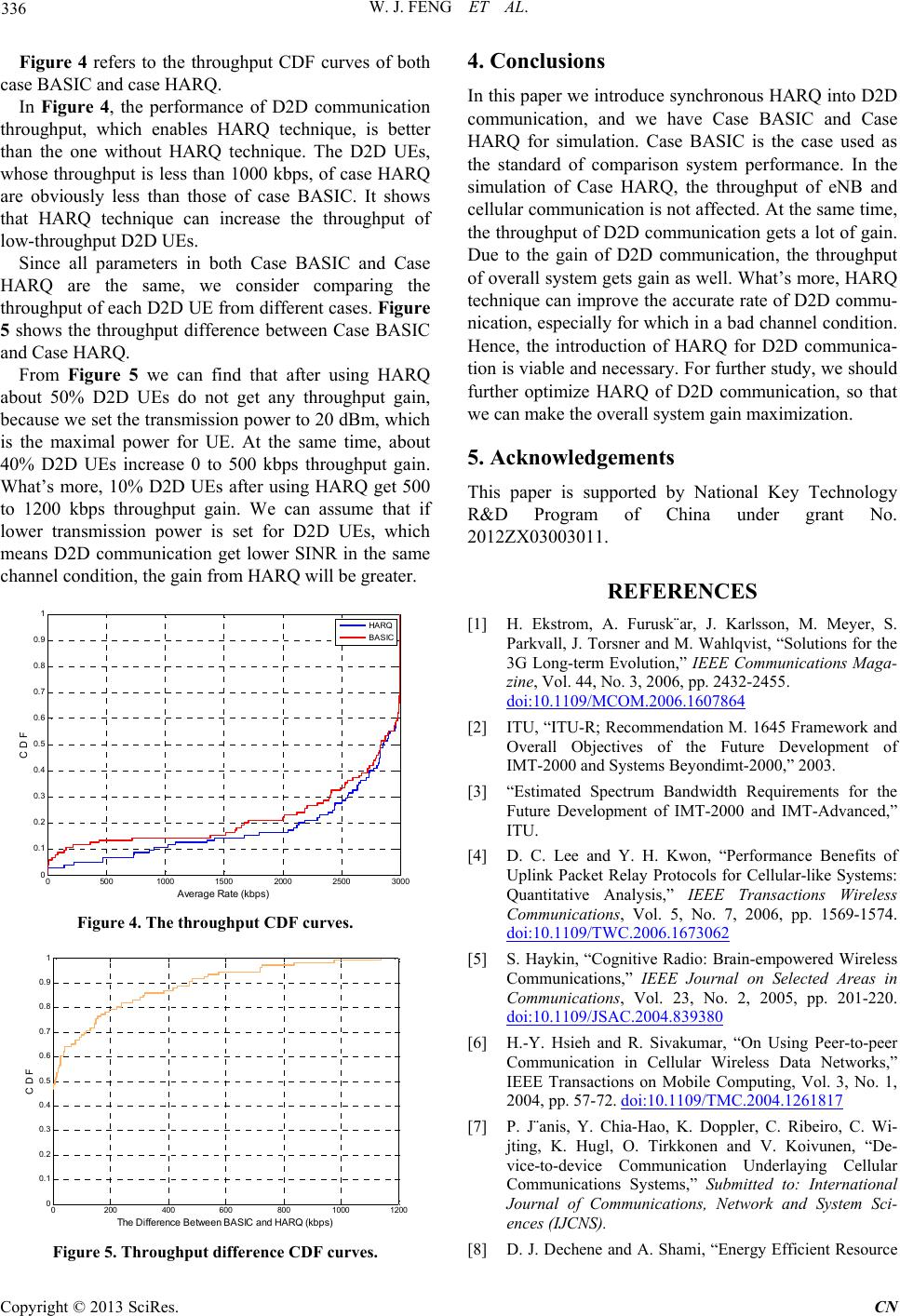
W. J. FENG ET AL.
336
Figure 4 refers to the throughput CDF curves of both
case BASIC and case HARQ.
In Figure 4, the performance of D2D communication
throughput, which enables HARQ technique, is better
than the one without HARQ technique. The D2D UEs,
whose throughput is less than 1000 kbps, of case HARQ
are obviously less than those of case BASIC. It shows
that HARQ technique can increase the throughput of
low-throughput D2D UEs.
Since all parameters in both Case BASIC and Case
HARQ are the same, we consider comparing the
throughput of each D2D UE from different cases. Figure
5 shows the throughput difference between Case BASIC
and Case HARQ.
From Figure 5 we can find that after using HARQ
about 50% D2D UEs do not get any throughput gain,
because we set the transmission power to 20 dBm, which
is the maximal power for UE. At the same time, about
40% D2D UEs increase 0 to 500 kbps throughput gain.
What’s more, 10% D2D UEs after using HARQ get 500
to 1200 kbps throughput gain. We can assume that if
lower transmission power is set for D2D UEs, which
means D2D communication get lower SINR in the same
channel conditio n, the gain from HARQ will be greater.
0500 1000 15002000 25003000
0
0.1
0.2
0.3
0.4
0.5
0.6
0.7
0.8
0.9
1
Av er age R a t e ( kbps )
C D F
HARQ
BASIC
Figure 4. The throughput CDF curves.
0200 4006008001000 1200
0
0. 1
0. 2
0. 3
0. 4
0. 5
0. 6
0. 7
0. 8
0. 9
1
T he Differ ence Bet w een BASI C an d H AR Q ( kbps)
C D F
Figure 5. Throughput difference CDF curves.
4. Conclusions
In this paper we introduce synchronous HARQ into D2D
communication, and we have Case BASIC and Case
HARQ for simulation. Case BASIC is the case used as
the standard of comparison system performance. In the
simulation of Case HARQ, the throughput of eNB and
cellular communication is not affected. At the same time,
the throughput of D2D communication g ets a lot of gain.
Due to the gain of D2D communication, the throughput
of overall system gets gain as well. What’s more, HARQ
technique can improve the accurate rate of D2D commu-
nication, espe cially for which in a bad channel condition .
Hence, the introduction of HARQ for D2D communica-
tion is viable and necessary. For further study, we should
further optimize HARQ of D2D communication, so that
we can make the overall system gain maximization.
5. Acknowledgements
This paper is supported by National Key Technology
R&D Program of China under grant No.
2012ZX03003011.
REFERENCES
[1] H. Ekstrom, A. Furusk¨ar, J. Karlsson, M. Meyer, S.
Parkvall, J. Torsner and M. Wahlqvist, “Solutions for the
3G Long-term Evolution,” IEEE Communications Maga-
zine, Vol. 44, No. 3, 2006, pp. 2432-2455.
doi:10.1109/MCOM.2006.1607864
[2] ITU, “ITU-R; Recommendation M. 1645 Framework and
Overall Objectives of the Future Development of
IMT-2000 and Systems Beyondimt-2000,” 2003.
[3] “Estimated Spectrum Bandwidth Requirements for the
Future Development of IMT-2000 and IMT-Advanced,”
ITU.
[4] D. C. Lee and Y. H. Kwon, “Performance Benefits of
Uplink Packet Relay Protocols for Cellular-like Systems:
Quantitative Analysis,” IEEE Transactions Wireless
Communications, Vol. 5, No. 7, 2006, pp. 1569-1574.
doi:10.1109/TWC.2006.1673062
[5] S. Haykin, “Cognitive Radio: Brain-empowered Wireless
Communications,” IEEE Journal on Selected Areas in
Communications, Vol. 23, No. 2, 2005, pp. 201-220.
doi:10.1109/JSAC.2004.839380
[6] H.-Y. Hsieh and R. Sivakumar, “On Using Peer-to-peer
Communication in Cellular Wireless Data Networks,”
IEEE Transactions on Mobile Computing, Vol. 3, No. 1,
2004, pp. 57-72. doi:10.1109/TMC.2004.1261817
[7] P. J¨anis, Y. Chia-Hao, K. Doppler, C. Ribeiro, C. Wi-
jting, K. Hugl, O. Tirkkonen and V. Koivunen, “De-
vice-to-device Communication Underlaying Cellular
Communications Systems,” Submitted to: International
Journal of Communications, Network and System Sci-
ences (IJCNS).
[8] D. J. Dechene and A. Shami, “Energy Efficient Resource
Copyright © 2013 SciRes. CN